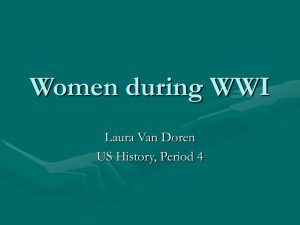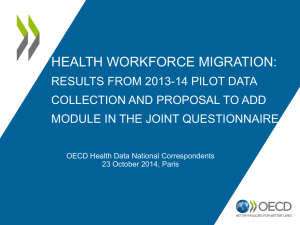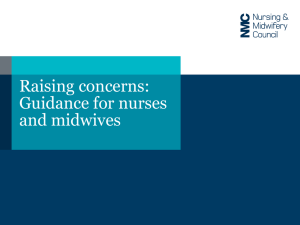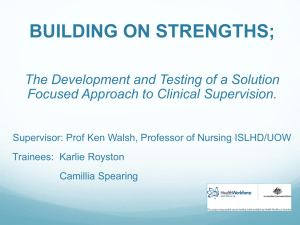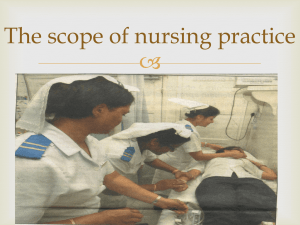Predisposing Factors For Stress Among Nurses Working In Critical
advertisement
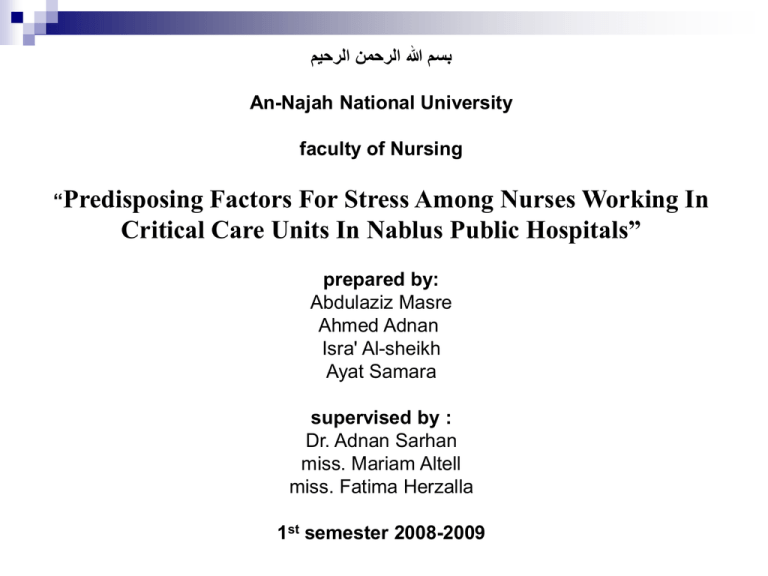
بسم هللا الرحمن الرحيم
An-Najah National University
faculty of Nursing
“Predisposing
Factors For Stress Among Nurses Working In
Critical Care Units In Nablus Public Hospitals”
prepared by:
Abdulaziz Masre
Ahmed Adnan
Isra' Al-sheikh
Ayat Samara
supervised by :
Dr. Adnan Sarhan
miss. Mariam Altell
miss. Fatima Herzalla
1st semester 2008-2009
Introduction
Stress is a well-known and identified problem within the
nursing profession. It is important to understand that the very
nature of nursing is stressful, increasing the vulnerability of all
nurses to the hazards of occupational stress (Smith et al., 2001).
Identification of job related stressors and strategies that can be
employed to manage occupational stress for the nursing
profession have been receiving increased consideration by
researchers, nursing organizations, and employers over the last
two decades (Cox & Griffiths, 1996) .
The environment of critical care units has been recognized as
stressful since their inception in the 1960’s .
Critical care nurses confront death and dying, end of life
decisions, and ethical dilemmas regularly. In addition to providing
vigilant care to their patients, critical care unit nurses interact
frequently with distraught families.
Conflicting values between nurses, physicians, and coworkers
create additional tensions in the units. However, the acute
shortages of nurses especially in critical care units has prompted
considerable research related to the identification of stressors for
this group of nurses.
Research has indicated that increased stress can lead to job
dissatisfaction, burnout, and precipitate attrition from critical care
units, thereby increasing employment costs. Prolonged exposure
to stress may lead to a variety of physical and psychological
disorders (Smith et al., 2001)..
The aim of study , is to identify the predisposing factors for
stress (stressors) among nurses working in critical care units in
Nablus public hospitals, and to explore the relationship between
predisposing factors of stress (stressors) and presented
variables ( age, gender, work experience, and work place).
methodology
Aim of the study:
1)- To identify the major predisposing factors for stress
( stressors) among nurses working in critical care units in Nablus
public hospitals.
2)- To explore the relationship between predisposing factors of
stress (stressors) and presented variables ( age, gender, work
experience, and work place).
Study design:
A descriptive, non experimental study.
Study question:
1)-what is the major predisposing factors for stress (stressors)
among nurses working in critical care units in Nablus public
hospitals ?
2)-what is the relationship between predisposing factors of stress
(stressors) and presented variables ( age, gender, work
experience, and work place) ?
Problem statement :
Is there a relationship between working in critical care units and
developing stress among nurses working in this area?
Hypothesis:
1)- There is no significant statistical differences at α=0.05 between
predisposing factors of stress among critical care nurses in
Nablus public hospitals and age variable.
2)- There is no significant statistical differences at α=0.05 between
the predisposing factors of stress among critical care nurses in
Nablus public hospitals and gender variable.
3)- There is no significant statistical differences at α=0.05
between
the predisposing factors of stress among critical care nurses in
Nablus public hospitals and work experience variable.
4)- There is no significant statistical differences at α =0.05
between the predisposing factors of stress among critical care
nurses in Nablus public hospitals and work place variable {ICU,
ER, hemodialysis).
Setting:
public hospitals in Nablus city.
Population:
Population of this study involves both male and female nurses
who are working in the critical care units in Nablus public
hospitals.
Sample:
A convenience sample of 50 nurses who are working in critical
care units in Nablus public hospitals.
Inclusion criteria:
Nurse's age >= 21 years old .
Nurses with at least 1 year of critical care experience .
Tool of data collection :
An adopted questionnaire (Hussein, H. (2003). Jordan magazine
for applied sciences) was distributed for nurses who are working
in critical care units in Nablus public hospitals, to identify the
major sources of stress among them.
Questionnaire consist of two parts :
Part one: Demographic variables ( age, gender, marital status,
scientific qualification ,work experience, work place {ICU, ER,
hemodialysis} ).
Part two: consist of 6 criteria that represent the major sources of
stress among critical care nurses, include the following :
1)- Workload.( points 1-12).
2)- Unfair policy of the hospital. (points 13-17) .
3)- Conflict with physicians, nurses and supervisors.( points 18-23).
4)- Inadequate preparation to deal with the emotional needs of
patients and their families. (points 24-32) .
5)- Dealing with death and dying, and appropriate decision making.
(points 33-37) .
6)- Lack of staff support.( points 38-40) .
The answers depend on Likert Scale which consist of 4 scales :
(strongly disagree (1), disagree (2), agree (3), strongly agree (4) ) .
Limitations:
1)- small sample which consists of 50 critical care nurses only.
2)- and the setting is two public hospitals in Nablus city only .
The results and Conclusions:
After data statistical analysis using SPSS program the study has
the following results :
First: results related to the questionnaire questions :
QN
1.
Workload.( points 1-12)
2.
Unfair policy of the hospital . (points 13-17)
3.
4.
percentage
Predisposing factors for stress (stressors)
63.20 %
62.88 %
Conflict with physicians, nurses and supervisors.( points 18-23)
54.60 %
The emotional needs of patients and their families. (points 2461.82 %
32)
5.
Dealing with death and dying . (points 33-37)
6.
Lack of staff support.( points 38-40)
66.96 %
54.40 %
The previous table shows the following conclusion:
The major predisposing factor for stress (stressor) among critical
care nurses in Nablus public hospitals is Dealing with death and
dying with percentage (66.96%), followed by workload with
percentage (63.20%), followed by unfair policy of hospital with
percentage (62.88 %), followed by the emotional needs of the
patients and their families with percentage (61.82 %), followed by
Conflict with physicians, nurses and supervisors with percentage
(54.60 %), and finally lack of staff support with percentage (54.40
%) .
This conclusion is supported by: Research by Foxall
and associates indicated that critical care unit nurses
experienced significantly more stress related to death
and dying (Foxall et.al.1990).
Second: the results related to hypothesis:
First hypothesis:
“There is no significant statistical differences at α=0.05 between
the predisposing factors of stress among critical care nurses in
Nablus public hospitals and age variable”.
Result:
The Sig. level is 2.400 which is greater than level assumed in
hypothesis (0.05). So we accept the hypothesis and say that
“there is no significant statistical differences at α=0.05 between
the predisposing factors of stress among critical care nurses in
Nablus public hospitals and age variable”.
Second hypothesis:
“There is no significant statistical differences at α=0.05 between
the predisposing factors of stress among critical care nurses in
Nablus public hospitals and gender variable”.
Result:
The Sig. level is 0.061 which is greater than assumed grade in
hypothesis (0.05). So we accept the hypothesis and say “there
is no significant statistical differences at α=0.05 between the
predisposing factors of stress among critical care nurses in
Nablus public hospitals and gender variable”.
Third hypothesis:
“There is no significant statistical differences at α=0.05 between
the predisposing factors of stress among critical care nurses in
Nablus public hospitals and work experience variable”.
Result:
The Sig. level is 1.100 which is greater than level assumed in
hypothesis (0.05). So we accept the hypothesis and say that
“there is no significant statistical differences at α=0.05 between
the predisposing factors of stress among critical care nurses in
Nablus public hospitals and work experience variable”.
Fourth hypothesis :
“There is no significant statistical differences at α=0.05 between
the predisposing factors of stress among critical care nurses in
Nablus public hospitals and work place variable”.
Result:
The Sig. level is .007 which is less than level assumed in
hypothesis (0.05). So we reject the hypothesis and say that “there
is significant statistical differences at α=0.05 between the
predisposing factors of stress among critical care nurses in
Nablus public hospitals and work place variable”.
Recommendations
1)- Nurses need to feel that they are involved in decision making
especially related to patient care issues. Therefore a more
decentralized, democratic management approach would be
beneficial .
2)- Break down barriers of communication between physicians
and nurses, and promote collaboration between nursing and
medical services. This can be accomplished by creating open
forums, group discussions, and collaborative workshops.
Organizations must develop and strictly enforce policies for
disruptive behavior in the workplace .
3)- Provide access to educational programs, not only in clinical
areas, but in teamwork, communication, family interactions, and
stress management .
4)- The development of an ethics forum would give nurses a place
to express their concerns. about end-of communication, family
-life issues and other ethical concerns.
5)- Stress management programs, Increasing flexibility of
scheduling and shifts will enhance the workplace, and Skills
and knowledge can be shared, enhancing team-building.


